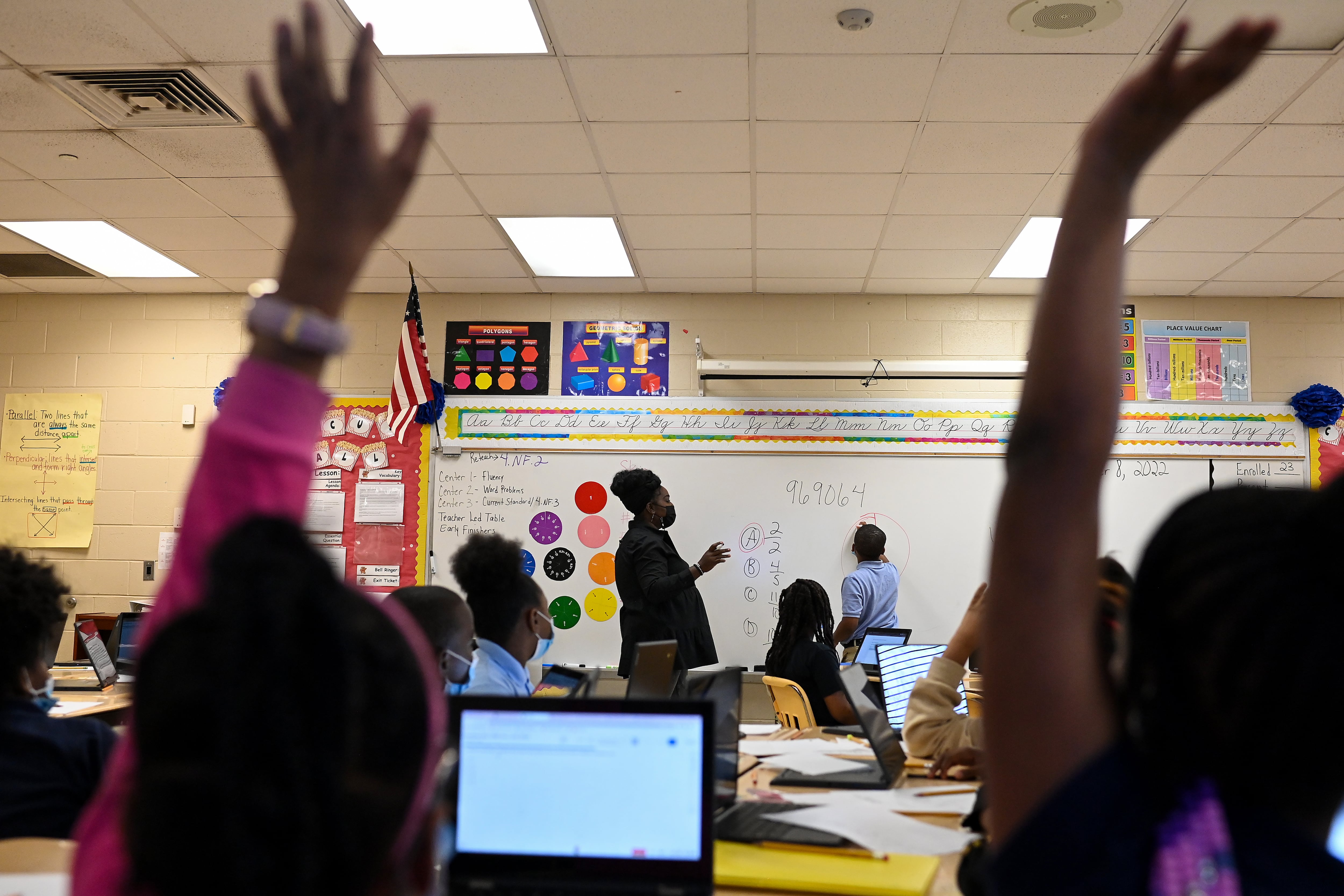Sign up for Chalkbeat’s free weekly newsletter to keep up with how education is changing across the U.S.
Some have called it the “Mississippi miracle.” Others say not so fast.
In the last decade, Mississippi students have rapidly closed the test score gap with the nation as a whole, particularly in fourth grade. State officials, education wonks, and national journalists have attributed these improvements to the state’s 2013 early reading law, which included emphasizing phonics and holding back third graders who struggle to read.
The purported link between the state’s policies and its upward trajectory has become one of the nation’s most talked-about education stories.
“Mississippi has shown that it is possible to raise standards even in a state ranked dead last in the country in child poverty and hunger,” New York Times columnist Nick Kristof wrote in May.
State policymakers elsewhere are paying attention: Some say they’re modeling new laws after Mississippi’s.
But a few commentators have pushed back on this rosy narrative. Los Angeles Times columnist Michael Hiltzik recently claimed scores had been “gamed.”
So who’s right?
In short, the state’s educational improvement appears to be legitimate and meaningful. It’s true that calling these gains a “miracle” seems overstated, and some questions about them warrant further investigation. But there’s little if any evidence they’re artificially inflated.
There is still one big question that hasn’t been conclusively answered, though: Why did the state experience such large improvements?
Some research supports the prevailing explanation that Mississippi’s early literacy policies contributed to better test scores. But other states have implemented similar policies and not seen gains nearly as large. It’s not clear what explains the Magnolia State’s outsized improvements.
Call it the Mississippi mystery.
Mississippi closes the gap on national tests
For decades, Mississippi’s test scores have been far below the national average. But between 2013 and 2019, the state’s students made big strides on the National Assessment of Educational Progress (NAEP), a closely watched test given periodically to fourth and eighth graders. These gains are all the more striking because national test scores stagnated during this time.
By 2019, Mississippi was at about the national average in fourth grade math and reading. In eighth grade, it was still below average, but the gap with the nation had shrunk.
Mississippi’s schools look even better after taking into account the fact that it has an extremely high child poverty rate, which is correlated with lower test scores. An analysis of 2019 scores by the Urban Institute showed that — adjusted for demographics, including family income and race — Mississippi was one of the country’s top-rated states in fourth grade and above average in eighth grade.
In 2022 in the wake of the pandemic, the state saw sharp drops in test scores, but the same was true in the country as a whole.
Critiques of the state’s gains fall short
Hiltzik, the Los Angeles Times columnist, advanced two major critiques of the state’s test score gains in a recent column.
First, he argued that by holding back struggling third-graders, the state had inflated its test scores by removing those students from the pool of fourth grade test-takers.
In reality, this could help explain test scores jumps for a short period of time, but it doesn’t make much sense for longer-term gains. Eventually, students who are retained in early grades will move up to the next grade — they are not held back forever. Because Mississippi has seen sustained improvements, retention gaming appears to be an unlikely explanation.
Another critique is that the gains in fourth grade had “vanished by the eighth grade,” as Hiltzik put it. This claim is misleading. Between 2013 and 2022, Mississippi had roughly cut in half the test score gap in eighth grade between itself and the nation. Although this is not as large as the gains in fourth grade, it is still substantial.
Some of the disconnect between early and later grades may also reflect the fact that fourth graders who took the NAEP in 2019 and saw improved scores had not yet reached eighth grade for the 2022 exam.
Andrew Ho, a testing expert at Harvard University and previously a member of the board that oversees NAEP, said his instinct is to question big test score gains. But in the case of Mississippi, he said, “I don’t see any smoking guns or red flags that make me say that they’re gaming NAEP.”
Impact of state test change may be worth examining
One sometimes overlooked change in Mississippi education policy in the last decade involved not curriculum or instruction, but its testing regimen.
In 2015, Mississippi overhauled its state test, including by aligning it more closely with NAEP.
“When writing the new assessment, the Mississippi Department of Education looked at NAEP frameworks — the blueprints for the content and design of each assessment — to ensure that the new state assessment mirrored expectations on The Nation’s Report Card,” according to a publication from the board that oversees NAEP.
Testing experts say that focusing on the content of a particular exam might improve scores because educators teach to that specific test. This is not necessarily bad if the content reflects what students should know.
Still, NAEP is supposed to be an external check on state assessments and if the two tests are very similar, it might not serve that purpose as well. “To the extent you prioritize NAEP, you risk inflating NAEP scores,” said Ho.
However, the state testing shift began in 2015, while NAEP gains began in 2013. Additional scrutiny might shed more light on this issue.
Early literacy law might be part of explanation
The commonly told story for why Mississippi has apparently seen substantial improvements in student learning has a clear protagonist: Its early literacy law.
“Progress began after the 2013 passage of the Literacy-Based Promotion Act,” former Mississippi Governor Phil Bryant wrote recently. “The genius behind this law comes from its ability to reach students when it counts and identifies K–3 students who need additional reading help as early as possible.”
NAEP scores on their own cannot show cause and effect, but some research supports this explanation.
One study found that retained third graders in Mississippi subsequently made large test score gains. Another recent study looked at a number of states, including Mississippi, that had adopted comprehensive early literacy policies. This was defined by a set of sixteen policies supported by the advocacy group ExcelinEd, including training in the “science of reading,” grade retention, reading coaches, and more. (ExcelinEd, founded by former Florida Governor Jeb Bush, encourages states to model its policies after Florida’s and played a key role in supporting Mississippi’s 2013 law.)
The researchers found that states with all these policies in place made bigger gains on the NAEP reading tests than states without those policies or only some policies in place. The improvement amounted to four to five points in fourth grade reading several years after the enactment of a state’s early literacy law.
“Retention, coupled with this wide range of supports for teachers and students, may be the most effective way to improve students’ literacy learning,” said Amy Cummings, a graduate student at Michigan State University and coauthor of the study.
Mississippi’s fourth grade reading scores jumped by ten points between 2013 and 2019 — more than other states that enacted similar laws. Some of those gains came between 2013 and 2015, before the law had been fully implemented. For instance, the law’s third grade retention mandate didn’t begin to apply until 2015. The state also saw similarly large gains in math.
This implies the state’s gains were partly but not entirely due to the reading law.
What else could explain the improvements? Rachel Canter, executive director of the education advocacy group Mississippi First, hypothesizes that the state’s focus on aligning its standards, testing, and accountability system — and sticking with it for many years — paid off.
“We were raising standards, raising expectations — teachers were actively trying to meet those raised standards and expectations and then we were testing on them,” she said. Perhaps this was particularly helpful since the state’s students were starting at a low level of performance.
But many other states also adopted new standards and testing during this period and didn’t experience much growth.
Ultimately, this uncertainty suggests that states that adopt Mississippi-like early reading policies might expect to see some meaningful gains, but shouldn’t expect Mississippi-sized improvements.
Matt Barnum is a national reporter covering education policy, politics, and research. Contact him at mbarnum@chalkbeat.org.




